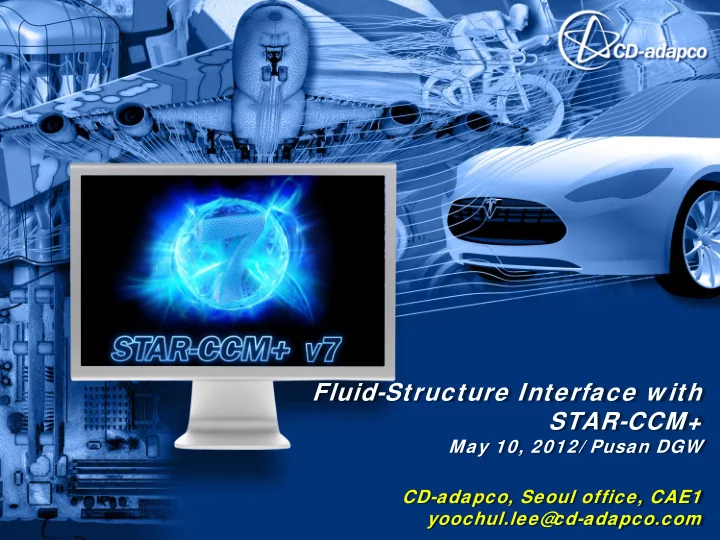

Fluid-Structure Interface w ith STAR-CCM+ May 10, 2012/ Pusan DGW CD-adapco, Seoul office, CAE1 yoochul.lee@ cd-adapco.com
Introduction to this presentation • Fluid Structure Interaction (Flow/ Thermal/ Stress) – FSI for structural engineers? • FSI related in CD-adapco – Only 30 min. at this event (broad & not specific) – Limited validation cases and NDA issues – Only for ABAQUS Co-simulation? – FSI domestic training course will be available – Contact us if you have FSI problem to solve !!!
Introduction to this presentation • Contents – The challenges of FSI – DATA exchanges with FEA codes (ANSYS, NASTRAN) – ABAQUS Co-simulation interface – FSI validation cases – Meeting the Challenges of FSI
The Challenges of FSI • Mapping data techniques – Finding neighbors and interpolating • Protocols and formats for exchanging data – Getting data from Code A to Code B • Coupling methods – Algorithms for accuracy, stability • Dynamic fluid mesh evolution – Topology changes in the fluid domain • Validation of FSI results
The Challenges of FSI : DATA EXCHANGE • Process of DATA Exchange between codes
The Challenges of FSI : DATA EXCHANGE • File Based Transfer: Import/Map/Export – Data exchange via files on a hard-disk – CAE code need not be resident in memory – Often called “Loose Coupling” – User responsible for exchange synch • Socket Based Transfer: Co-Simulation API – CAE code and STAR-CCM+ in memory – Data exchanged via sockets – API controls exchange synchronization
DATA EXCHANGE: w orking w ith ANSYS • Preparing DATA in ANSYS – Surface and volume used for FSI interface – The string “FSI” should be used for data mapping – SURF154(traction), SURF152(thermal) – Imported into STAR-CCM+ in *.cdb format [CDWRITE, ALL,<filename>.cdb] • Importing ANSYS Solution Data – By creating .lis file /output, fname, ext PRNSOL, NAME, OPT PRNSOL, TEMP PRNSOL, U, COMP /output
DATA EXCHANGE: w orking w ith ANSYS • Preparing DATA in ANSYS – Surface and volume used for FSI interface – The string “FSI” should be used for data mapping – SURF154(traction), SURF152(thermal) – Imported into STAR-CCM+ in *.cdb format [CDWRITE, ALL,<filename>.cdb] • Importing ANSYS Solution Data – By creating .lis file /output, fname, ext PRNSOL, NAME, OPT PRNSOL, TEMP PRNSOL, U, COMP /output
DATA EXCHANGE: w orking w ith ANSYS • Mapping STAR-CCM+ solution to ANSYS mesh – Using source/target proximity checks in STAR-CCM+ – Mapping tools: each fluid boundary to ANSYS exterior surface • Exporting to ANSYS – Via ANSYS macro scripts – “/INPUT, <filename><extension> for appropriate load step activated – Data exported will set valued in ANSYS model e.g.) surface: D, SFE, Volume: BF
DATA EXCHANGE: w orking w ith NASTRAN • Preparing DATA in NASTRAN – Import of shells, volumes(solids) and surface element – Through .nas or .bdf • Importing NASTRAN Solution Data – Form Output 2(.op2), Bulk Data file (.bdf) or (.nas) • Exporting to NASTRAN – Mapped onto an imported NASTRAN model can be exported from STAR-CCM+ to external files – By using INCLUDE ‘starccm_pressure.nas’
DATA EXCHANGE: ABAQUS Co-simulation • Coupling via Abaqus Co-Simulation API of SIMULIA – Manages Coupling Synchronization/Exchange/Mapping – Abaqus v6.12/STAR-CCM+ v7.04 (implicit coupling) • STAR-CCM+ >> Abaqus (explicit or standard) – Initial geometry – Pressure(relative or absolute pressure) – Shear traction – Surface heat flux • Abaqus >> STAR-CCM+ – Displacement, velocity – Temperature
STAR-CCM+/ABAQUS Co-simulation 12
Co-Simulation: STAR-CCM+ DFBI • STAR-CCM+ Dynamic Fluid Body Interaction • Fluid loads passed to ABAQUS “on the fly” • As for the fluid, the structure is rigid
Co-Simulation: One Way Coupled Results • Free surface/ Pressure load calculated in STAR-CCM+
Co-Simulation: Plate VIV • Elastic plate perpendicular to air stream – 10 cm x 8 cm x 2.5mm – density and modulus such that • 1 st bending mode @ 4Hz • 1 st twisting mode @ 20 Hz • Compressible air moving at 10 m/s, Re=5e4 – K- ω turbulence model, Unsteady RANS – Rigid plate, computed Cd=2.0, Str=0.156 • Vortex shedding frequency @ 19.5 Hz • Produces very small twisting moment
Quasi-Steady Response • All post-processing capabilities available
Experimental Validation: Wedge Wet Drop • Comparison of Experiments and Models • Peterson, Wyman, and Frank: “ Drop Tests to Support Water-Impact and Planing Boat Dynamics Theory ”, Dahlgren Division Naval Surface Warfare Center, CSS/TR-97/25 • STAR-CCM+ VOF with different bodies – Rigid Body (6DOF, DFBI) – Elastic Body (FV stress) – Elastic Body (Abaqus Co-Simulation)
Wedge Drop In Water • Meaningful data acquired Vertic tical l Equi quivalent nt S Stres ess accel elerat ation on (MP (MPa) Angul ular ar a accel eler eration on (rad/ ad/s 2 )
Benchmark: VIV of Cylinder/Cantilevered Plate • FSI3 Benchmark of Turek & Hron Loa Loads and and Displacements withi hin n 10% 10% of of Benc nchm hmar ark Numer erical al Resul ults
Wind Turbine Under Quasi-Steady Loads • Windward Displacement can be evluated
Co-Simulation DOT Tank Impact • Experimental impact & Numerical Analysis
DOT Tank Impact Comparisons • Analysis results (impact force[kips]) 1400 1200 1000 800 600 400 200 0 0 0.1 0.2 0.3 0.4 0.5
Meeting the Challenges of FSI • CD-adapco is committed to providing state of the art tools to meet the challenges of FSI – Mapping Data Techniques – Procedures for Exchanging Data – Coupling Methods – Dynamic Fluid Mesh Evolution – Validations • Integrating these tools into the workflow processes of our Customers • Again, Please contact us if you need more information !!!
Recommend
More recommend